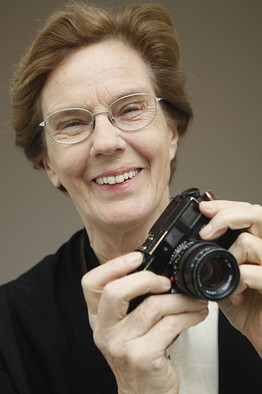Martine Franck (Martine Franck)

Franck was born in Antwerp to a Belgian banker and his British wife, and after her birth the family moved almost immediately to London. A year later, her father joined the British army, and the rest of the family was evacuated to the United States, spending the remainder of the Second World War in Long Island and Arizona. Franck’s father was an amateur art collector who often took his daughter to visit galleries and museums. Franck was in boarding school from the age of six onwards, and her mother sent her a postcard every day, frequently of paintings. Franck said that in high school she loved art history, and planned to become a curator.
Franck studied art history at the University of Madrid and at the Ecole du Louvre in Paris. After struggling through her thesis (on French sculptor Henri Gaudier-Brzeska and the influence of cubism on sculpture), she said she realized she had no particular talent for writing, and turned to photography instead. In 1963, Franck became an assistant to photographers Eliot Elisofon and Gjon Mili at Time-Life in Paris. By 1996 she was a busy freelance photographer for magazines such as Vogue, Life and Sports Illustrated, and the official photographer of the Théâtre du Soleil (a position she held for 48 years). From 1970 to 1971 she worked in Paris at the photo agency Vu, and in 1972 she co-founded the photo agency Viva.
In 1980, Franck joined the famous Magnum cooperative photo agency as a “nominee”, and in 1983 she became a full member. She was one of a very small number of women to be accepted into the agency. In 1983, she completed a project for the now-defunct French Ministry of Women’s Rights and in 1985 she began collaborating with the non-profit International Federation of Little Brothers of the Poor. In 1993, she first traveled to the Irish island of Tory where she documented the tiny Gaelic community living there. She has also traveled to Tibet and Nepal, and with the help of Marilyn Silverstone photographed the education system of the Tibetan Tulkus monks. In 2003 and 2004 she returned to Paris to document the work of theater director Robert Wilson who was staging La Fontaine’s fables at the Comédie Française. Nine books of Franck’s photographs have been published, and in 2005 Franck was made a chevalier of the French Légion d’Honneur.
Franck was often described as elegant, dignified and shy. In 1966, Franck met Henri Cartier-Bresson, thirty years her senior, when she was photographing Paris fashion shows for the New York Times. In 2010, she told interviewer Charlie Rose “his opening line was, ‘Martine, I want to come and see your contact sheets.’” They married in 1970, had one child, a daughter named Mélanie, and remained together until his death in 2004.
Throughout her career Franck, who was sometimes described as a feminist, was uncomfortable being in the shadow of her famous husband and wanted to be recognized for her own work. In 1970, the Institute of Contemporary Arts in London planned to stage Franck’s first solo exhibition: when she saw that the invitations included her husband’s name and said he would be present at the launch, she cancelled the show. Franck once said that she put her husband’s career ahead of her own. In 2003 Franck and her daughter launched the Henri Cartier-Bresson Foundation to promote Cartier-Bresson’s photojournalism, and in 2004 Franck became its president. Franck was diagnosed with leukemia in 2010, and died in Paris in 2012.
Franck was well known for her documentary-style photographs of important cultural figures such as painter Marc Chagall, philosopher Michel Foucault and poet Seamus Heaney, and of remote or marginalized communities such as Tibetan Buddhist monks, elderly French people, and isolated Gaelic speakers. She cited as influences the portraits of British photographer Julia Margaret Cameron and the work of American photojournalist Dorothea Lange and American documentary photographer Margaret Bourke-White. In 2010, she told the Times that photography “suits my curiosity about people and human situations.” She worked outside the studio, using a 35-millimeter Leica camera, and preferring black-and-white film. The British Royal Photographic Society has described her work as “firmly rooted in the tradition of French humanist documentary photography.”
Born
- April, 02, 1938
- Antwerp, Belgium
Died
- August, 16, 2012
- Paris, France

